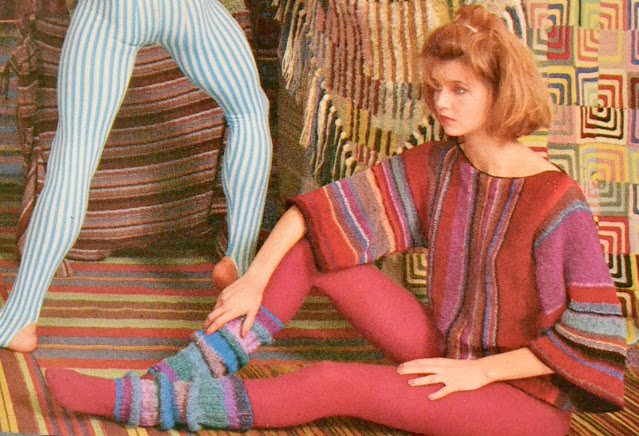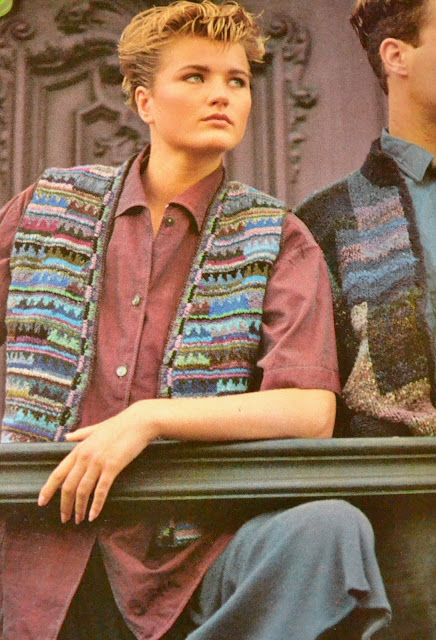Those of you who stop by to read this blog regularly will most probably be familiar with Pickle, my 8.5 year-old Tuxedo Cat, who frequently features on the blog in her capacity as knitting cupboard inspector, model and product tester extraordinaire.
In the pictures below, she can be seen
- modelling the Cat Leg Warmer (or a swatch of cartridge rib in the round)
At the end of November 2017, I discovered blood in Pickle's stool. This prompted a visit to the vet's. During her initial examination she was found to require dental treatment (including extractions) and we were advised to change her diet to chicken in broth with rice. Despite the nutritional changes, her diarrhoea continued and every third to fourth bowel movement contained blood. At a subsequent consultation with her vet, she was deemed fit to undergo dental surgery despite her digestive issues. In fact, both the vet and us were guessing that her digestive issues might potentially be connected to the state of her teeth; and that by removing this inflammatory culprit, the issues around her digestion would resolve as a result. She was booked in for surgery just before the end of the year.
In addition to her pre-op blood tests, I decided to take full advantage of her time under anaesthetic to obtain abdominal x-rays and to carry out histological tests on a small polyp, which I discovered on her rectum shortly before her dietary issues emerged. Even though I didn't like the look of the polyp, neither of the vets, who examined her, seemed particularly concerned about this small growth on her behind. Both advised that colorectal polyps were generally more common in uncastrated dogs and that polyps in this location were not commonly encountered amongst feline patients.
Neither her blood test, including complete blood count, nor her abdominal x-rays, which would have shown any obstructions or palpable internal tumours, gave us any cause for concern. Her vet appeared confident that, all being well with the histological tests, Pickle was either passing blood due to the ongoing issues with her teeth and / or she was exhibiting the classic signs of feline Irritable Bowel Disease (IBD).
Following her operation, Pickle returned home in the early evening the same day. Within a matter of days she was back to her usual self. Probably as a result of her dental extractions, she even appeared more active than before. The bland diet, which we kept up, decreased the frequency of her bowel movements drastically. Despite this, she continued to harbour a healthy appetite. Sadly, she also continued to produce bloody stools, albeit at a reduced rate.
In the evening of 4th January, whilst I was in the middle of a chaotic commute home from London, I received the results of the histological tests from her vet over the phone. It was bad news. That was the night Cancer moved into my life and took hold of it. If you and a beloved pet are or have been affected by Cancer, my heart goes out to you.
 |
| Pickle (in one of her favourite places - in the midst of freshly laundered bed linen) on 19th January 2018, roughly two weeks after her cancer diagnosis. |
The mass examined was found to be malignant (Adenocarcinoma), most likely a colorectal Adenocarcinoma. Her vet admitted that he would not have expected this result when he relayed her 'very guarded prognosis'. Based on the medical statistics available for this type of cancer, which is relatively rare in cats, he indicated that her life expectancy could range from 8 weeks to 18 months.
In the midst of a packed train, I tried to keep a stiff upper lip, asked all the questions that appeared to be of immediate concern (Is she likely to be in pain? - No. Is there anything we need to do right now? - No.) and arranged another consultation to discuss Pickle's prognosis in more detail. I arrived home that night and couldn't even cry. Instead, I was in shock and at a complete loss, not knowing how to start tackling the problem. Even though I was fearful of the polyp being cancerous, I had never really contemplated this being a possible outcome. I had no Plan B.
The follow-up consultation with her vet was not until around 7 days later and I had to somehow bridge that gap. Whilst it's easy to get carried away emotionally when you are confronting this Goliath-type adversary, I somehow knew that I had to contain my emotions in order to concentrate all my waking energy on thinking clearly, gaining knowledge and making smart decisions on Pickle's behalf. And FAST.
I soon found out that the presence of Cancer and a work life do not mix well, especially if you attempt to keep on functioning in the latter. I completely stopped eating and, as a result of sleepless nights and countless hours researching the web, I physically caved in halfway through the following week. By the time the vet appointment was upon us, I was on antibiotics for tonsillitis, full of cold and my GP was particularly concerned about my anxiety. I was not able to switch off and my brain was working at full capacity any time, all the time. Feeling physically shit was ok though. As long as I was able to do something constructive and, above all, spend time with Pickle, my anxiety was bearable. With a notebook full of questions, mainly concerning the histological report, cancer staging and treatment options, we returned to the vet's.
During the consultation, her vet explained Pickle's further treatment options in more detail. Adenocarcinoma is a type of cancer that has the ability to move fast, affecting other organs as it spreads. In order to establish the stage of her cancer, we would either have to resort to invasive surgery or get her booked in for MRI scanning. Both procedures would require another anaesthetic, a lengthy journey to a clinic with appropriate facilities and, if opting for invasive surgery, an overnight stay at the vet's.
 |
| Pickle on 19th January 2018, sporting a post-op shave on the right side of her neck |
Ignoring the financial aspects (I would remortgage the house if I had to) considering the stress and impact on Pickle's emotional and physical health, neither of these options seemed appropriate. From a medical point of view, given the absence of a palpable tumour, the chances of successfully removing cancerous tissue during surgery are slim, especially as we don't know where and whether it has spread. Chemo - and radiotherapy are equally unsuitable. Unlike certain types of Lymphoma, Adenocarcinoma is not particularly responsive to either treatment options and both might do more harm than good, especially if, assuming best case scenario, we have nipped Pickle's cancer in the proverbial 'butt' with the removal of the polyp from her rectum.
This leaves us with the final option: shifting the focus from the cancer found in the tissue sample to concentrating our efforts on improving the symptoms of her IBD, whilst simultaneously boosting her immune system. Conventionally, severe cases of IBD are often treated with the help of corticosteroids, which - when managed carefully in conjunction with dietary intervention - can produce good results. Having lived with a Terrier, who spent the best part of his life on corticosteroids and made it to 13 years, I am not necessarily averse to their use. Yet, corticosteroids negatively affect other organs when used over a prolonged period and, by implication, will shorten the life expectancy of the patient.
Considering Pickle's overall condition - she is not lethargic, shows no signs of pain, has not lost any weight and continues to display a healthy appetite even for the bland food we have served up over the past month - I had made my decision that 'Pickle on 'Roids'' wasn't an option, at least not until all other routes had been exhausted.
In the various consultations with Pickle's conventional vet, he must have sensed my reservations in respect of conventional treatments. From my comments on immunisation to microchipping and the application of parasite treatments such as Bayer's Advocate, he was probably expecting my next turn already. Thankfully, he appeared to back my approach: the holistic route.
Having read many accounts of owner's grappling with their cat's cancer in recent weeks, I am aware that in many cases conventionally trained vets are often not supportive of this route. This comes as no surprise, and the recent spat between the RCVS (Royal College of Veterinary Surgeons) and the BAHVS (the British Association of Homeopathic Veterinary Surgeons) serves as a timely reminder of the frictions between both 'camps'. (More here.)
Every case is, of course, unique and there may be valid reasons why a conventional approach should be favoured over holistic treatments. Yet, in Pickle's case, he backed the idea of getting a holistic vet on board, if only to delay the use of corticosteroids by exploring raw feeding, dietary supplementation and other holistic remedies.
And this is where we are right now. After more research and days spent discussing Pickle's case with various holistic vets across the country, 'Team Pickle' was joined by another member at the onset of last week. Meanwhile, the patient herself appears content. Her last two bowel movements contained no visible blood, she maintains a healthy appetite, has recovered from the upheaval of the vet visits and seems to enjoy life as before, maybe even more, bearing in mind that she is now rid of her painful teeth. By simply looking at her right now, no one would assume that she was diagnosed with Adenocarcinoma. Further updates will follow.
 |
| Pickle on 19th January 2018, 2 weeks after her cancer diagnosis |


















